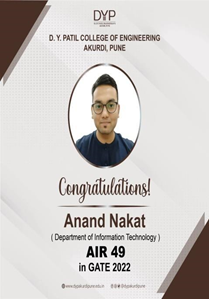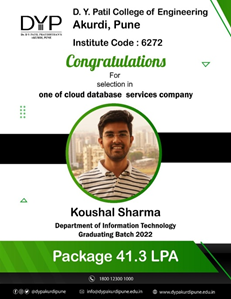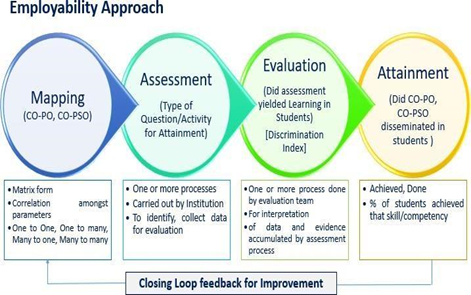- About DYPCOE
- Branchwise intake
- Code of conduct policy
- Best Practice-1
- Best Practice-2
- Institutional Distinctiveness
|
Title of the practice: |
Holistic Development of Students for Higher Package Jobs by formulation of PSO mapping and attainment aligned with Alumni Profiles |
||
|
Objective of the practice: |
1. To train the students and to enhance quantitative and qualitative aptitude. 2. To provide a platform to the students for showcasing their technical knowledge as per the needs of the industry. 3. To provide good offers through corporate cell of Institute during campus recruitment 4. To make students aware of alumni profiles and prepare them as per industrial requirement. 5. To appraise students the skills and competencies required to fulfill in market. |
||
|
The Context: |
The Institute concentrates on work integrated learning through training and placement cell in equipping new graduates with the required employability skills. Student’s participation in internship gives them confidence and motivation through stipend. CO-Learning strategy is adopted for internship, which helps students to learn newer methods, cutting edge technologies and employability opportunities in the future to build upon. Third Year students were trained by external agencies like Campus credentials and Ethnus based on Aptitude test skills, technical coding skills, company specific questions and Resume writing etc. The Institute enhances industry-institute interface, networking within the industry for placement and training interventions for enhancing student’s capability. Program Outcomes are developed in students through alumni expert sessions. OBE - outcome-based education focuses on making students employable. Any professional degree education's end conclusion or net result can be evaluated by either placement (on campus, off campus, higher education), or entrepreneurship.
|
||
|
The practice: |
OBE for Teaching Learning process: Students and faculty members have completed certifications and value-added programs for gap fulfillment with respect to Industry requirements.Faculty has been playing a vital role in guiding and mentoring students to select the right choice of courses and further counsel them to prepare for placement and higher education selection process. The impact of the guiding and mentoring system observed as this scheme helps to reduce productive wastage of time that otherwise can be utilized for learning by students. Institute offers employability skills development training programs from high repute third party vendors during their TE. Alumni are strong assets of the Institute. Departments and T&P cells have consistently arranging various activities to cater the students as per the upcoming need of the Industry in advanced technologies. Technical activities are organized under various Professional Bodies and Students Association to groom the students and make them technically competent. Google Developer Student Club is established in the Institute from 2020 to train and learn technologies of Google platforms to the students of all departments. Core areas are always specific to each program like Manufacturing, Design in Mechanical Engineering, Sensors and Embedded systems in Electronics, construction in Civil engineering and likewise. Broad areas consist of core along with the other areas of working which can be seen mostly through the alumni profile. Similar to the basic areas of computer engineering are Web and Software development, Communication, Programming, Networking while broadened fields include signal processing, high performance computing, embedded systems, VLSI design, and many inline disciplines.
Depth of T = Alumni’s working in Core area / Total No. of alumni's. The percentage of depth refers to the number of curricular gaps needed to meet PO and PSO requirements. Opportunities in the program are growing when broad regions are shallower than core areas. else it will be diminishing accordingly. Participation of Alumni’s profile will be considered for PSO formulation Pros of designing PSOs based on alumni characteristics include - 1. Adoption of the alumni growth trend line in OBE. 2. To educate teachers about the problems faced by alumni as a result of changes in skills and competencies and technological advancements in the business world. 3. Whether the Present skills and competencies developed in the students are aligned with alumni profiles or not can be outlined through the CO-PSO Mapping. 4. Encourage educators to create lesson plans and pedagogy that will help |
||
|
Evidence of success: |
Following are the statistics of higher packages received for students during the placement of academic year 2022.
|
|
|
Below are some evidences of success of higher package students:
Following are the PSO statements framed through the case study conducted from Electronics alumni. 1. PSO1 (A few key categories delineated from Alumni Profiles recruited during UG course placements): Graduates design, test, and validate time switches, timers, PLCs, GSM controllers, temperature controllers, signal transducers, modular power supplies, and instrumentation devices in the electronics industries. They also embed software engineers or train to be software engineers in the transportation sector, along with network planning engineers for all long-distance routes in the country. 2. PSO2 (Some of the significant areas noted in the Alumni Profiles of those who continued their studies after completing their UG): to improve analytical, computational, and computationally intensive problem-solving abilities in the fields of electronic circuits, communication, signal processing, and control systems. 3. PSO3 (Some of the key industries where alumni launched their businesses): Graduates launch their businesses in industries like website development, renewable energy, and digital branding, among others.
|
|
Problems Encountered and Resources Required: |
As students were well aware about the market scenario and competition lined up for them in this corporate world, considering this in mind, students were expecting more such training. Also students should be trained using some hands-on training or through visits to industrial premises or Corporate world. Students were not aware of the advantages of such a method. Therefore, initially students were made aware of curriculum gaps and bloom’s taxonomy level requirements to enhance their employability. This has helped to overcome the thinking of students who were considering assessment as a burden. Also, to make calculations of each outcome, were lengthy and susceptible for fatigue by faculty. Therefore, software named attainDI was developed and made available on the website. |



